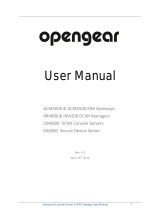
3
Table of Contents
5. Firewall, Failover and OOB Access 75
5.1 Dialup Modem Connection 75
5.2 OOB Dial-In Access 75
5.2.1 Configure Dial-In PPP 76
5.2.2 Using SDT Connector Client 78
5.2.3 Set Up Windows XP or Later Client 78
5.2.4 Set Up Earlier Windows Clients 79
5.2.5 Set Up Linux Clients 79
5.3 Dial-Out Access 79
5.3.1 Always-On Dial-Out 80
5.3.2 Failover Dial-Out 81
5.4 OOB Broadband Ethernet Access 82
5.5 Broadband Ethernet Failover 83
5.6 Cellular Modem Connection 84
5.6.1 Connecting to a 4G LTE 85
Carrier Network
5.6.2 Verifying the Cellular Connection 86
5.6.3 Cellular Modem Watchdog 87
5.6.4 Dual SIM Failover 88
5.6.5 Automatic SIM Slot Detection 88
5.6.6 Multi-Carrier Cellular Support 89
5.7 Cellular Operation 91
5.7.1 Set Up OOB Access 91
5.7.2 Set Up Cellular Failover 92
5.7.3 Cellular Routing 93
5.7.4 Set Up Cellular CSD Dial-In 94
5.8 Firewall and Forwarding 95
5.8.1 Configuring Network Forwarding 95
and IP Masquerading
5.8.2 Configuring Client Devices 97
5.8.3 Port / Protocol Forwarding 99
5.8.4 Firewall Rules 101
5.8.5 Packet State Matching in 103
Firewall Rules
6. SSH Tunnels and SDT Connector 105
6.1 Configuring for SSH Tunneling 105
to Hosts
6.2 SDT Connector Client Configuration 105
6.2.1 SDT Connector Client Installation 106
6.2.2 Configuring a New Gateway in 106
the SDT Connector Client
6.2.3 Auto-Configure SDT Connector 107
Client with the User’s Access
Privileges
6.2.4 Make an SDT Connection 108
Through the Gateway to a Host
6.2.5 Manually Adding Hosts to the 108
SDT Connector Gateway
6.2.6 Manually Adding New Services 109
to the New Hosts
6.2.7 Adding a Client Program to Be 111
Started for the New Service
6.2.8 Dial-In Configuration 112
6.3 SDT Connector to Management 113
Console
6.4 SDT Connector: Telnet or SSH 114
Connect to Serially Attached Devices
6.5 Using SDT Connector for 115
Out-of-Band (OOB) Connection to
the Gateway
6.6 Importing (and Exporting) 116
Preferences
6.7 SDT Connector Public Key 116
Authentication
6.8 Setting up SDT for Remote 117
Desktop Access
6.8.1 Enable Remote Desktop on the 117
Target Windows Computer to
Be Accessed
6.8.2 Configure the Remote Desktop 118
Connection Client
6.9 SDT SSH Tunnel for VNC 119
6.9.1 Install and Configure the VNC 119
Server on the Computer to be
Accessed
6.9.2 Install, Configure and Connect 121
the VNC Viewer
6.10 Using SDT to IP Connect to Hosts 122
that are Serially Attached to the
Gateway
6.10.1 Establish a PPP Connection 123
between the Host COM Port and
Console Server
6.10.2 Set Up SDT Serial Ports on 125
Console Server
6.10.3 Set Up SDT Connector to SSH 125
Port Forward over Console Server
Serial Port
6.11 SSH Tunneling Using Other SSH 125
Clients (e.g. PuTTY)
6.12. VNC Security 128


























